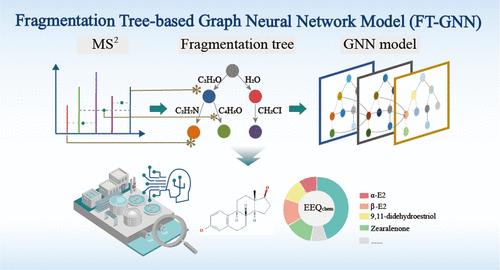连接HRMS特征和生物活性的FT-GNN工具:揭示污水中未知的雌激素受体激动剂
IF 11.3
1区 环境科学与生态学
Q1 ENGINEERING, ENVIRONMENTAL
引用次数: 0
摘要
确定城市污水中的雌激素受体(ER)激动剂对确保水环境的健康至关重要。由于污水的化学成分复杂多变,主要的内质网激动剂仍不清楚。基于高分辨率质谱(HRMS)的模型已被开发用于预测复杂基质中化合物的生物活性,但需要进一步优化以有效地将HRMS特征与ER激动剂连接起来。为了解决这一挑战,提出了一种基于碎片树的图神经网络(FT-GNN)模型。考虑到有限的数据和类别不平衡,使用适用性域(AD)和过采样技术(OTE)的模型预测进行数据扩充。模型开发结果表明,将FT-GNN与数据增强相结合可使平衡精度(bACC)值提高6%-31%。所开发的模型具有较高的bACC,可以识别更多真正的内质网激动剂,有效地分类了污水中数万种未识别的HRMS特征,减少了非靶向筛选的后处理工作量。对污水处理过程中内质网激动剂转化的分析表明,厌氧阶段是其去除和形成的关键。雌激素效应平衡分析表明,α-E2和9,11-二去氢雌三醇可能是两个以前被忽视的关键内质网激动剂。总之,FT-GNN模型的开发和应用是可信跟踪和有效控制水中雌激素风险的关键进步。本文章由计算机程序翻译,如有差异,请以英文原文为准。

FT-GNN Tool for Bridging HRMS Features and Bioactivity: Uncovering Unidentified Estrogen Receptor Agonists in Sewage
Identifying primary estrogen receptor (ER) agonists in municipal sewage is essential for ensuring the health of aquatic environments. Given the complex and variable chemical composition of sewage, the predominant ER agonists remain unclear. High-resolution mass spectrometry (HRMS)-based models have been developed to predict compound bioactivity in complex matrices, but further optimization is needed to effectively bridge HRMS features with ER agonists. To address this challenge, an FT-GNN (fragmentation tree-based graph neural network) model was proposed. Given limited data and class imbalance, data augmentation was performed using model predictions within the applicability domain (AD) and oversampling technique (OTE). Model development results demonstrated that integrating the FT-GNN with data augmentation improved the balanced accuracy (bACC) value by 6%–31%. The developed model, with a high bACC to identify more true ER agonists, efficiently classified tens of thousands of unidentified HRMS features in sewage, reducing postprocessing workload in nontargeted screening. Analysis of ER agonist transformation during sewage treatment revealed the anaerobic stage as key to both their removal and formation. Estrogenic effect balance analysis suggests that α-E2 and 9,11-didehydroestriol may be two previously overlooked key ER agonists. Collectively, the development and application of the FT-GNN model are crucial advancements toward credible tracking and efficient control of estrogenic risks in water.
求助全文
通过发布文献求助,成功后即可免费获取论文全文。
去求助
来源期刊

环境科学与技术
环境科学-工程:环境
CiteScore
17.50
自引率
9.60%
发文量
12359
审稿时长
2.8 months
期刊介绍:
Environmental Science & Technology (ES&T) is a co-sponsored academic and technical magazine by the Hubei Provincial Environmental Protection Bureau and the Hubei Provincial Academy of Environmental Sciences.
Environmental Science & Technology (ES&T) holds the status of Chinese core journals, scientific papers source journals of China, Chinese Science Citation Database source journals, and Chinese Academic Journal Comprehensive Evaluation Database source journals. This publication focuses on the academic field of environmental protection, featuring articles related to environmental protection and technical advancements.
 求助内容:
求助内容: 应助结果提醒方式:
应助结果提醒方式:


